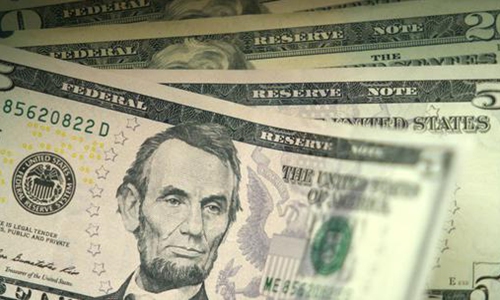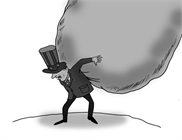
Photo taken on March 3, 2020 shows U.S. dollar banknotes in Washington D.C., the United States. Photo:Xinhua
While both China and the US are battling the pandemic's economic crunch, it appears Chinese citizens are better positioned to face monetary pressure on it, say analysts.
Chinese urban households' standing debt to annual income ratio stood 1.02 percent, slightly higher than the US' 0.93 percent, as home mortgages account for a large chunk of China's household debts, a survey conducted by People's Bank of China, the country's central bank, in October showed.
Despite this, analysts note that China's high savings rate means that debt risk is controllable, while consumer debt-ridden US households are more fragile amid the global pandemic, plus the price of oil and stocks have plunged.
Of the over 30,000 respondents across 30 provinces and autonomous regions, 56.5 percent have debt, with the average level at 512,000 yuan ($72,303), according to the survey. But urban households' debts are mainly mortgages, which account for 75.9 percent of their total.
"Despite a large proportion, Chinese households' mortgage paying capability is more guaranteed, as the country's real estate is more stable than in the US during the 2007 subprime mortgage crisis," Dong Dengxin, the director of the Finance and Securities Institute at Wuhan University of Science and Technology, told the Global Times on Saturday.
The survey showed that Chinese families' debt-to-income ratio is at a relatively low level of 18.4 percent.
Tian Yun, vice director of the Beijing Economic Operation Association, told the Global Times that China's high savings could help the country ride out the fallout brought on by the global pandemic better than the US. "Chinese families' saving rate is over 25 percent, a stark contrast to the US' around 7 percent," he said, noting that many Americans would run out of cash in a month without any subsidy.
In the US, about 59 percent of credit card holders, or about 110 million adults, had credit card debt at the start of the coronavirus outbreak, recent data from CreditCards.com showed. Almost two-thirds of them accumulated the debt to pay for daily necessities like groceries, child care, and utilities, it said.
"Many adults were already teetering on the financial edge, reliant on credit cards to pay for day-to-day bills and emergencies at the start of the COVID-19 outbreak," Rossman said in a report on its website.
Credit card rates remain very high, over 17 percent for many cardholders, and US Federal Reserve's interest rate cuts won't provide much relief… Credit card debtors need to take matters into their own hands, Rossman said.
In addition, American families tend to hold more financial assets like stocks and futures contracts, which have fluctuated rapidly amid the virus outbreak, Tian said.
By comparison, Chinese urban families' total assets averaged 3.18 million yuan, with 59.1 percent in real estate. That is 28.5 percentage points higher than in the US, the survey showed.
Moreover, the distribution of wealth among urban households in China is more balanced compared with the US and China's top one percent of families account for 17.1 percent of the country's total household net assets, while their US counterparts own 38.6 percent.
Tian warned that the US' decoupling with China would do more damage to US households indirectly, saying that it's more urgent for them than China to resume business activities to help common families since the services sector creates over 80 percent of the jobs in the US.
The latest data from the US Labor Department showed on Thursday that another 4.4 million Americans filed for unemployment claims last week, sending the five-week total to over 26 million.

